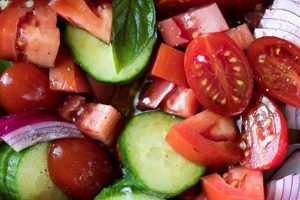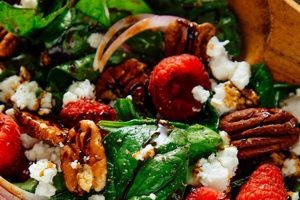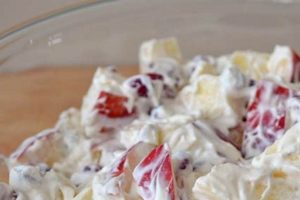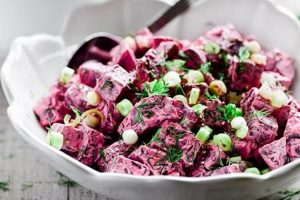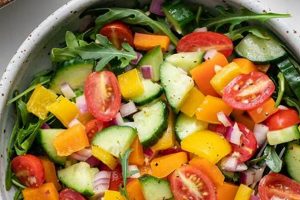A combination of shredded or chopped cheese, mayonnaise, and often other ingredients such as chopped vegetables, seasonings, or relish, served between slices of bread, constitutes a simple yet satisfying meal or snack. Variations can include different cheese types, bread choices, and added ingredients like mustard, onions, or pickles, offering a wide range of flavor profiles.
This readily customizable dish offers a convenient and affordable way to incorporate dairy, grains, and potentially vegetables into one’s diet. Its adaptability lends itself to diverse palates and dietary needs, as ingredients can be easily substituted or omitted. Historically, such combinations gained popularity with the rise of commercially available mayonnaise and processed cheese in the early 20th century, evolving from simpler bread and cheese meals.
The following sections will explore specific ingredient combinations, preparation techniques, and nutritional considerations related to creating flavorful and balanced versions of this classic dish.
Tips for Crafting the Perfect Cheese Salad Sandwich
Elevating a simple cheese salad sandwich requires attention to detail and an understanding of complementary flavors. These tips offer guidance on creating a superior culinary experience.
Tip 1: Cheese Selection is Paramount: Opt for cheeses with pronounced flavors and desirable textures. Sharp cheddar, Gruyre, or Havarti offer robust taste, while crumbled blue cheese or feta provide tangy complexity. Consider a blend of cheeses for a richer profile.
Tip 2: Mayonnaise Matters: High-quality mayonnaise forms the foundation of the salad. Experiment with flavored mayonnaises, or enhance plain mayonnaise with additions like Dijon mustard, horseradish, or a squeeze of lemon juice.
Tip 3: Bread Choice Enhances the Experience: Select bread that complements the chosen cheeses and fillings. Crusty sourdough, hearty rye, or a soft multigrain bread can each contribute distinct textures and flavors.
Tip 4: Freshness is Key: Utilize the freshest ingredients available. Crisp lettuce, ripe tomatoes, and finely chopped onions or celery elevate the overall quality and provide textural contrast.
Tip 5: Seasoning Enhances Flavor: Freshly ground black pepper, paprika, garlic powder, or a pinch of cayenne pepper can amplify the flavor profile without overpowering the delicate balance of the other ingredients.
Tip 6: Proper Assembly Ensures Success: Evenly distribute the cheese salad mixture across the bread slices to avoid a soggy or unevenly flavored sandwich. Consider adding a layer of butter to the bread for added richness and a barrier against moisture.
Tip 7: Temperature Influences Enjoyment: Serve the sandwich immediately after preparation for optimal freshness and flavor. Chilling the assembled sandwich briefly can enhance the flavors and create a firmer texture.
By following these guidelines, one can transform a simple cheese salad sandwich into a delectable and satisfying meal.
These insights offer a foundation for crafting exceptional cheese salad sandwiches. Experimentation with ingredients and techniques further personalizes the experience and expands culinary horizons.
1. Bread Choice
Bread choice significantly impacts the overall sensory experience of a cheese salad sandwich. The bread acts as both a structural foundation and a flavor component, influencing the final product’s taste, texture, and ability to hold the filling. Selecting the appropriate bread involves considering the cheese salad’s characteristics and the desired outcome. For a robust, sharp cheese salad, a hearty, dense bread like rye or pumpernickel provides a sturdy base and complements the strong flavors. Conversely, a milder cheese salad might benefit from a softer, more neutral bread like white or wheat, allowing the delicate flavors of the filling to shine. The bread’s texture also plays a crucial role. A crusty bread offers textural contrast, while a softer bread creates a smoother, more cohesive experience.
Consider a cheese salad featuring sharp cheddar, chopped onions, and a Dijon mustard-enhanced mayonnaise. A dense, seeded rye bread would stand up to the strong flavors and prevent sogginess. Alternatively, a creamy cheese salad with herbs and brie might pair well with a crusty baguette, providing a textural counterpoint to the soft filling. Matching bread density to the moisture content of the cheese salad also ensures structural integrity. A very moist cheese salad benefits from a denser bread to prevent structural failure and maintain a pleasant eating experience.
Appropriate bread selection elevates a cheese salad sandwich from simple to exceptional. Thoughtful consideration of flavor profiles, textures, and moisture levels ensures a harmonious balance between bread and filling, resulting in a truly satisfying culinary creation. Ignoring the importance of bread choice can lead to a disappointing sandwich experience, with flavors clashing or the structural integrity compromised. Understanding the relationship between bread and filling empowers informed decisions, resulting in a well-balanced and enjoyable meal.
2. Cheese Selection
Cheese selection significantly influences the flavor profile, texture, and overall quality of a cheese salad sandwich. The chosen cheese dictates the dominant taste, impacting how other ingredients interact and contribute to the final product. A sharp cheddar, for example, provides a robust, tangy base, while a milder Colby offers a creamier, more subdued flavor. Understanding the characteristics of different cheeses allows for informed decisions that align with desired outcomes. The cheese’s texture also plays a vital role. A crumbly feta adds a salty, tangy element and a unique textural dimension, whereas a smooth, creamy Havarti contributes a rich, buttery mouthfeel. The interplay of textures from different cheeses adds complexity and interest to the overall sensory experience.
Consider a cheese salad intended for a picnic. A firm, aged cheddar holds its shape well and offers a pronounced flavor that stands up to other ingredients. Conversely, a delicate, spreadable cheese like Boursin might not be suitable for a picnic setting due to its softer texture and susceptibility to temperature changes. The practicality of cheese selection extends beyond flavor and texture. Choosing pre-shredded cheese offers convenience, while grating a block of cheese freshly allows for control over texture and potentially enhances flavor. Combining different cheeses opens possibilities for creating complex flavor profiles. A blend of sharp cheddar and Gruyre, for instance, offers both sharpness and nutty undertones, resulting in a more nuanced taste experience. Alternatively, a mixture of Monterey Jack and pepper jack cheeses introduces both creamy and spicy elements, adding depth and complexity.
Effective cheese selection is essential for a successful cheese salad sandwich. Understanding the interplay of flavors, textures, and practical considerations ensures a well-balanced and enjoyable outcome. Careful cheese selection enhances the overall dining experience, from the initial bite to the lingering aftertaste. The chosen cheese forms the foundation upon which all other ingredients build, shaping the character and appeal of the final product. Neglecting the importance of cheese selection can result in a bland or unbalanced sandwich, highlighting the critical role this component plays in achieving a truly satisfying culinary creation.
3. Complementary Ingredients
Complementary ingredients play a crucial role in elevating a cheese salad sandwich beyond its basic components. These additions contribute contrasting textures, flavors, and visual appeal, transforming a simple combination of cheese and mayonnaise into a more complex and satisfying culinary experience. Strategic incorporation of complementary ingredients offers opportunities to personalize the sandwich, catering to individual preferences and creating a well-balanced flavor profile.
- Textural Elements
Ingredients providing textural contrast enhance the overall sensory experience. Crisp vegetables like chopped celery, shredded carrots, or diced bell peppers introduce a refreshing crunch, counterbalancing the smoothness of the cheese and mayonnaise. Toasted nuts or seeds offer a different type of crunch and contribute additional flavor complexity. These contrasting textures prevent the sandwich from becoming monotonous and provide a more dynamic mouthfeel.
- Flavor Enhancers
Flavor enhancers introduce depth and complexity to the cheese salad. Incorporating ingredients like chopped pickles, olives, or capers adds a salty, briny dimension, while a touch of sweetness from chopped dried cranberries or raisins can balance the savory elements. Fresh herbs like dill, chives, or parsley provide bright, herbaceous notes that complement the richness of the cheese. These flavor enhancers create a multi-layered taste experience, preventing the sandwich from tasting one-dimensional.
- Spices and Seasonings
Spices and seasonings further refine the flavor profile. A dash of freshly ground black pepper adds a subtle heat, while a pinch of paprika introduces a smoky warmth. Garlic powder or onion powder can amplify the savory notes, while a touch of cayenne pepper adds a spicy kick. These subtle additions elevate the overall flavor profile without overpowering the core ingredients. Careful balancing of spices ensures a harmonious blend of flavors.
- Acidic Components
Acidic components introduce brightness and balance to the richness of the cheese and mayonnaise. A squeeze of lemon juice or a splash of vinegar cuts through the richness and adds a refreshing tang. Chopped tomatoes or a layer of thinly sliced red onion also contribute acidity and enhance the overall flavor profile. These acidic elements prevent the sandwich from feeling heavy and create a more balanced taste experience.
The thoughtful incorporation of complementary ingredients transforms a basic cheese salad sandwich into a personalized culinary creation. The interplay of textures, flavors, and carefully selected additions elevates the sensory experience, demonstrating that even simple dishes can achieve remarkable depth and complexity through strategic ingredient combinations. By considering the various roles complementary ingredients can play, one can craft a cheese salad sandwich that caters to specific tastes and preferences, showcasing the versatility and potential of this classic dish.
4. Mayonnaise Quality
Mayonnaise serves as the foundational binding agent in a cheese salad sandwich, significantly influencing the final product’s flavor, texture, and overall quality. Its role extends beyond simply holding the ingredients together; mayonnaise contributes richness, creaminess, and subtle tanginess that interacts directly with the chosen cheeses and other components. Therefore, the quality of mayonnaise selected directly correlates with the overall sensory experience of the sandwich.
- Flavor Profile
Mayonnaise quality significantly impacts the flavor profile of the cheese salad filling. High-quality mayonnaise, typically made with fresh ingredients and minimal additives, offers a clean, balanced flavor that complements the cheese without overpowering it. Lower-quality mayonnaise, often containing artificial flavors and preservatives, can introduce unwanted sweetness or tanginess, masking the delicate flavors of the cheeses and other ingredients. For example, a cheese salad featuring a nuanced blend of Gruyre and Fontina would benefit from a high-quality mayonnaise with a subtle, neutral flavor, allowing the nutty and earthy notes of the cheeses to shine. In contrast, a lower-quality, overly tangy mayonnaise might clash with the delicate cheese flavors, resulting in an unbalanced and less enjoyable sandwich.
- Texture and Emulsion Stability
The texture and emulsion stability of mayonnaise directly affect the final consistency and structural integrity of the cheese salad sandwich. High-quality mayonnaise exhibits a smooth, creamy texture and a stable emulsion, preventing the separation of oil and water, which could lead to a watery or greasy filling. This stable emulsion ensures the cheese salad remains cohesive and maintains its desired texture. A lower-quality mayonnaise with a less stable emulsion might break down under pressure or with temperature fluctuations, resulting in a less appealing, separated filling that compromises the sandwich’s structural integrity and negatively impacts the eating experience. A sandwich made with a stable emulsion remains intact and enjoyable, while one with a broken emulsion can become messy and unappetizing.
- Ingredient Composition
The ingredients comprising the mayonnaise influence not only the flavor but also the nutritional value and overall quality of the cheese salad sandwich. High-quality mayonnaise typically features natural oils, fresh eggs, and minimal additives or preservatives. Conversely, lower-quality options might utilize processed oils, artificial flavors, and stabilizers, potentially impacting the nutritional content and introducing unwanted flavors. For instance, mayonnaise made with extra virgin olive oil contributes beneficial fats and a subtle fruity flavor, while mayonnaise made with processed soybean oil might lack comparable nutritional benefits and possess a less desirable flavor profile. This difference in ingredient composition can subtly but noticeably affect the overall taste and nutritional value of the final sandwich.
- Interaction with other Ingredients
The quality of mayonnaise influences how it interacts with other ingredients in the cheese salad sandwich. High-quality mayonnaise, with its balanced flavor and stable emulsion, acts as a harmonious backdrop, allowing the flavors of the cheeses, vegetables, and seasonings to meld together seamlessly. Lower-quality mayonnaise, with potentially overpowering flavors or an unstable emulsion, can clash with or mask the other ingredients, diminishing their impact and creating a less cohesive flavor profile. Consider a cheese salad with crisp cucumbers and fresh dill. A high-quality mayonnaise allows the refreshing cucumber and herbaceous dill flavors to shine, creating a balanced and flavorful combination. However, a lower-quality mayonnaise with a strong artificial tang might overwhelm the subtle flavors of the cucumber and dill, resulting in a less nuanced and enjoyable sandwich.
Mayonnaise quality plays a pivotal role in determining the success of a cheese salad sandwich. From flavor and texture to ingredient interaction and overall palatability, the choice of mayonnaise significantly influences the final product. Utilizing high-quality mayonnaise ensures the desired flavor profile, structural integrity, and optimal sensory experience, ultimately elevating the humble cheese salad sandwich from simple fare to a truly satisfying culinary creation. Overlooking the importance of mayonnaise quality can compromise the balance and overall enjoyment of this classic dish.
5. Seasoning Balance
Seasoning balance is crucial in a cheese salad sandwich recipe. It determines the overall flavor profile, enhancing the inherent qualities of the ingredients without overpowering the delicate balance of the dish. Proper seasoning elevates the sandwich from simple to sophisticated, transforming a basic combination of ingredients into a harmonious culinary experience. Understanding the nuances of seasoning allows for precise flavor adjustments, ensuring a consistently delicious and well-balanced sandwich.
- Salt Enhancement
Salt acts as a flavor enhancer, amplifying the existing tastes within the cheese salad filling. It heightens the savory notes of the cheese, brightens the flavors of any added vegetables, and balances the richness of the mayonnaise. However, excessive salt can mask the subtle nuances of the other ingredients and create an unpleasantly salty taste. A small amount of kosher salt, added gradually and tasted throughout the preparation process, allows for controlled flavor enhancement, ensuring a balanced and palatable outcome. For example, a cheese salad with sharp cheddar benefits from a touch of salt to accentuate its sharpness, while a milder cheese blend might require less salt to avoid overpowering its delicate flavor.
- Pepper Complexity
Freshly ground black pepper introduces complexity and depth to the cheese salad sandwich. Its subtle heat and nuanced aroma complement the richness of the cheese and add a layer of intrigue to the flavor profile. Different types of peppercorns offer varying levels of heat and aromatic complexity. For instance, black pepper provides a robust, pungent flavor, while white pepper offers a milder, earthier taste. The amount of pepper used should be carefully considered in relation to the other ingredients and the desired level of spiciness. A cheese salad with bolder flavors might benefit from a more generous amount of pepper, while a milder cheese blend requires a lighter touch to avoid overpowering the delicate balance.
- Herbaceous Accents
Fresh or dried herbs can introduce bright, herbaceous accents to the cheese salad, complementing the other flavors and adding a refreshing element. Dill, chives, or parsley, finely chopped and incorporated into the cheese mixture, provide vibrant green notes and enhance the overall sensory experience. The choice of herbs should align with the other ingredients in the salad. Dill pairs well with milder cheeses and cucumbers, while chives complement stronger cheeses and onions. Dried herbs offer a more concentrated flavor and should be used sparingly to avoid overpowering the other ingredients. Fresh herbs provide a brighter, more delicate flavor and can be used more generously.
- Acidic Balance
A touch of acidity balances the richness of the cheese and mayonnaise, adding a refreshing brightness to the cheese salad filling. A squeeze of lemon juice or a splash of white wine vinegar cuts through the richness and enhances the overall flavor profile. The acidity also helps to preserve the freshness of the salad and prevents the flavors from becoming dull. The amount of acid used should be carefully balanced to avoid overpowering the other ingredients. A small amount is often sufficient to achieve the desired brightness and balance, preventing the salad from becoming overly tart.
Achieving seasoning balance in a cheese salad sandwich involves a delicate interplay of salt, pepper, herbs, and acidity. Careful consideration of these elements ensures that the flavors of the cheese, mayonnaise, and any additional ingredients harmonize, creating a well-rounded and satisfying culinary experience. Over-seasoning can mask the subtle nuances of the ingredients, while under-seasoning can result in a bland and uninspired sandwich. The goal is to enhance, not overpower, the inherent flavors of the components, creating a balanced and delicious final product. Experimentation and gradual adjustments, guided by taste, are key to achieving seasoning perfection.
6. Assembly Technique
Assembly technique significantly influences the structural integrity, even flavor distribution, and overall enjoyment of a cheese salad sandwich. Proper assembly ensures the sandwich holds its shape, prevents sogginess, and delivers a balanced bite of all ingredients in every mouthful. Overlooking this critical step can result in a structurally unsound and unevenly flavored sandwich, diminishing the overall dining experience. The following facets of assembly technique highlight its importance in crafting a successful cheese salad sandwich.
- Bread Preparation
Proper bread preparation forms the foundation of a well-constructed cheese salad sandwich. Evenly spreading a thin layer of softened butter or mayonnaise on both slices of bread creates a barrier against moisture from the cheese salad filling, preventing sogginess and maintaining structural integrity. This barrier also adds a subtle richness and enhances the overall flavor profile. Additionally, toasting the bread lightly can further enhance the textural contrast and provide a crisp counterpoint to the creamy filling. Neglecting this step can result in a soggy, structurally compromised sandwich with uneven flavor distribution.
- Filling Distribution
Even distribution of the cheese salad filling across the bread surface ensures a balanced flavor in every bite. An unevenly distributed filling can lead to some bites being overloaded with cheese salad while others consist primarily of bread. Careful spreading of the filling from edge to edge creates a consistent flavor profile throughout the sandwich. This attention to detail elevates the eating experience, ensuring each bite offers a harmonious blend of all ingredients. Conversely, a haphazardly assembled sandwich can result in a disorganized and less satisfying culinary experience.
- Ingredient Layering
Strategic ingredient layering can further enhance the flavor and textural complexity of a cheese salad sandwich. Placing ingredients like lettuce or tomato slices directly against the bread can create an additional moisture barrier, further protecting against sogginess. Additionally, layering ingredients of varying textures, such as crunchy vegetables or crispy bacon, adds textural contrast and prevents the sandwich from becoming monotonous. Thoughtful layering enhances both the flavor and sensory experience of the sandwich, demonstrating that even simple additions can significantly impact the overall quality.
- Cutting and Presentation
The final step, cutting and presentation, contributes to the overall aesthetic appeal and ease of consumption. Cutting the sandwich into halves or quarters creates manageable portions and facilitates even distribution of the filling. A clean, sharp knife ensures a neat cut, preventing the filling from being squeezed out and maintaining the sandwich’s structural integrity. While often overlooked, proper cutting and presentation enhance the visual appeal and contribute to a more enjoyable dining experience. A neatly presented sandwich is more appetizing and reflects the care taken in its creation, further elevating the perceived quality of the dish.
Consideration of these assembly techniques significantly impacts the final quality and enjoyment of a cheese salad sandwich. From bread preparation and filling distribution to ingredient layering and final presentation, each step contributes to a structurally sound, evenly flavored, and aesthetically pleasing sandwich. Proper assembly techniques elevate this simple dish, demonstrating that attention to detail transforms basic ingredients into a satisfying culinary experience. Overlooking these techniques can result in a less enjoyable and potentially messy sandwich, underscoring the importance of proper assembly in achieving the desired outcome.
Frequently Asked Questions
This section addresses common inquiries regarding the preparation and enjoyment of cheese salad sandwiches, offering practical guidance and clarifying potential misconceptions.
Question 1: What is the best type of cheese for a cheese salad sandwich?
Optimal cheese selection depends on individual preferences, but cheeses with firm textures and pronounced flavors, such as sharp cheddar, Gruyre, or Havarti, often provide a satisfying base. Softer cheeses like brie or cream cheese can be incorporated, but require careful handling to prevent excessive softening or structural compromise.
Question 2: How can sogginess be prevented?
Sogginess can be mitigated by spreading a thin layer of butter or mayonnaise on the bread slices before adding the filling. This creates a barrier against moisture migration from the cheese salad. Selecting denser bread varieties or lightly toasting the bread also helps prevent sogginess. Additionally, consuming the sandwich shortly after preparation minimizes moisture absorption.
Question 3: Can cheese salad sandwiches be prepared in advance?
While best enjoyed immediately after assembly, cheese salad sandwiches can be prepared a few hours in advance. To maintain optimal quality, store the assembled sandwiches in an airtight container refrigerated until ready to serve. This helps maintain freshness and prevents the bread from drying out.
Question 4: What are some healthy additions to a cheese salad sandwich?
Incorporating chopped vegetables, such as celery, carrots, cucumbers, or bell peppers, enhances nutritional value and adds textural complexity. Adding lean protein, like shredded chicken or turkey, further increases the nutritional density. Sprouts, such as alfalfa or radish sprouts, offer additional nutrients and a subtle peppery flavor.
Question 5: How can one adjust the flavor profile of a cheese salad sandwich?
Flavor adjustments can be achieved through various additions. Incorporating different mustards, such as Dijon or whole grain, introduces complexity. Adding spices, like paprika or garlic powder, enhances savory notes. Incorporating chopped fresh herbs, such as dill or chives, contributes freshness. A splash of hot sauce adds a spicy kick.
Question 6: Are there alternatives to mayonnaise in a cheese salad sandwich?
Alternatives to mayonnaise include plain Greek yogurt, mashed avocado, or hummus. These options offer different flavor profiles and potential nutritional benefits. However, they may alter the texture and consistency of the traditional cheese salad filling.
Understanding these commonly addressed concerns enables informed decisions regarding ingredient selection, preparation techniques, and storage methods, ultimately contributing to a more satisfying cheese salad sandwich experience.
The following section provides a selection of cheese salad sandwich recipes, offering practical examples of the principles discussed above.
Conclusion
Exploration of the cheese salad sandwich recipe reveals a dish offering significant versatility and culinary potential. From bread selection and cheese choices to complementary ingredients and seasoning balance, each component contributes to the final product’s flavor profile, textural complexity, and overall enjoyment. Proper assembly techniques further ensure structural integrity and prevent sogginess, highlighting the importance of thoughtful preparation in achieving a satisfying culinary outcome. Addressing common inquiries regarding ingredient selection, preparation methods, and potential modifications provides a comprehensive understanding of this adaptable dish.
The cheese salad sandwich, often perceived as a simple meal, presents opportunities for culinary creativity and personalized flavor combinations. Strategic ingredient selection and meticulous attention to detail elevate this classic dish beyond its humble origins. Further experimentation and exploration of flavor profiles promise continued enjoyment and appreciation of the cheese salad sandwich’s enduring appeal.


